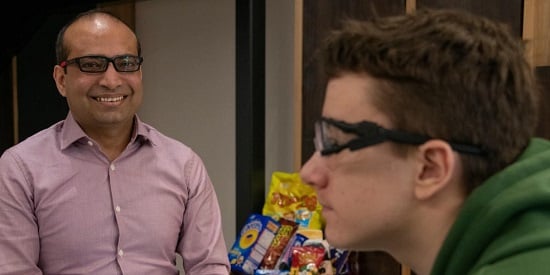Deakin eye tracking tech measures kids' attraction to junk food ads
Media release
Deakin scientists will use revolutionary eye tracking devices to work out how and why junk food commercials appeal to kids, in the hope of understanding how cancer-causing products are marketed to children.
The world-first research program is set to examine the visual factors that cause children to take up harmful habits such as junk food, alcohol, and cigarettes; employing iPupilX eye tracking technology originally developed for use by the military and elite athletes.
Associate Professor Asim Bhatti, an expert in cognition and performance assessment at Deakin's Institute for Intelligent Systems Research and Innovation (IISRI) said the project was the first time scientists would be able measure how much kids pay attention to junk food advertising outside of a laboratory setting.
"The significant benefit of eye tracking technology is that we'll be able to see what's more catchy and engaging to children as they go about their normal day-to-day activities," Associate Professor Bhatti said.
"The devices can be worn during normal activities and routines, and they detect when changes occur in a child's pupil, which indicates that they're paying attention and focused on something.
"Previously this sort of work has been done in controlled experimental settings where children aren't in their natural state. That can affect how they concentrate on what's presented to them.
"Now we'll be able to get a true sense of the impact of junk food advertising on children as they go about their regular activities in a totally normal way."
Associate Professor Bhatti said the project's eye tracking technology has been used by the military to assess soldiers in the field during training and deployment, to understand the way they focus and concentrate on various tasks and threats.
"It makes sense to adapt this technology to help fight the global obesity crisis, because the principle here is the same," he said.
"If junk food and alcohol advertising are the threats, we want to know what our children are seeing - and what's attracting them to commercials that influence their health choices and threaten their long-term well-being."
The project is a collaboration between IISRI and Deakin's Global Obesity Centre (GLOBE), a World Health Organization Collaborating Centre for Obesity Prevention based within the University's Institute for Health Transformation.
GLOBE director and lead researcher Associate Professor Kathryn Backholer said understanding how kids engaged with various forms of advertising and marketing strategies would support future policies to protect children and the wider public health.
"Children have never been as engaged with digital and social media platforms as they are now, and with this comes an exposure to high volumes of junk food and alcohol marketing that's increasingly sophisticated in targeting children and those susceptible to the messaging," Associate Professor Backholer said.
"We're responding to an urgent need that's threatening the health of children around the world."
The Deakin-led eye-tracking project is supported by Cancer Council Victoria through its Venture Grants program.

